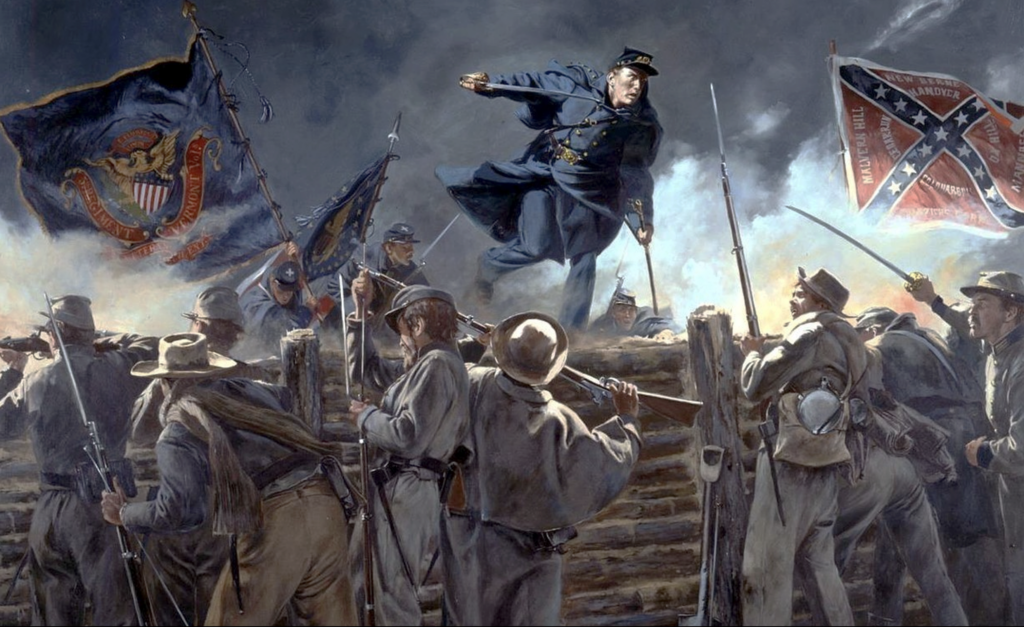
Breakthrough at Petersburg
The Breakthrough at Petersburg — April 2, 1865
Cold. Wet. Silent but for the rattle of accouterments and the hushed prayers of men who knew the coming hour might be their last.
In the predawn darkness of April 2nd, 1865, over 14,000 soldiers of the Union Sixth Corps waited in the freezing Virginia mud. Faces were set, jaws clenched. They gripped cold metal barrels of their rifles, boots sinking into the mire outside Fort Fisher, Fort Welch, and Fort Gregg. Among them were veterans with thousand-yard stares and fresh-faced boys who swallowed hard, eyes wide in the dark.
General Horatio Wright rode along the lines, his breath clouding in the chill. He spoke quietly to officers, giving final instructions. Behind him loomed Major General John Gibbon’s 24th Corps, ordered to follow close and exploit any gap.
Less than a mile away, Confederate pickets peered into the blackness, nerves taut. Sharpshooters from Brigadier General Samuel McGowan’s South Carolinians shivered at their posts, listening to the unnatural commotion. Something was wrong. Shots cracked in the dark as they fired at moving shadows, bullets seeking unseen targets.
A Union officer fell with a muffled cry, blood spilling onto frozen ground. But the Federal line held its silence. No return fire answered. Officers hissed orders for quiet—the element of surprise was everything.
Waiting for the Dawn
Hours crawled past like wounded animals. Soldiers shifted, whispered, prayed. A hush fell so complete it felt like the earth itself was holding its breath. Then, from Fort Fisher, a signal rocket split the black, hissing like a serpent.
4:40 a.m.
The order was shouted down the line: Advance!
The ground seemed to quake as the Union line surged forward. A ragged battle cry rose. Bayonets gleamed like teeth.
McGowan’s South Carolinians opened fire wildly, muzzle flashes flaring. They fell back in a panic, rallying behind Brigadier General James Lane’s North Carolinians in the main works. Artillery roared. Shells burst overhead in cruel white flowers of fire.
The Vermont Brigade Leads the Charge
In the center, Brevet Major General George Getty’s Division surged forward. Brigadier General Lewis Grant’s famed Vermont Brigade was in the lead, though Grant himself lay bleeding from a head wound, felled by a Confederate sniper hours before. Colonel Amasa Tracy now barked orders with a raw voice.
Swamps sucked at boots. Darkness turned ranks into stumbling mobs. Tracy’s Vermonters kept moving, grim and silent, bayonets fixed. Captain Charles Gould of the 5th Vermont was among the first to mount the Confederate works.
He screamed as three bayonet and saber thrusts ripped into him, blood soaking his coat. A Confederate leveled a musket to Gould’s chest at point-blank range—but the powder fizzled, the ball never fired. Clawing, punching, stabbing, his men piled over after him, dragging Gould down behind the parapet, still alive despite his wounds.
“All I saw was blood and shadows,” one Vermonter recalled. “We just kept stabbing.”
Colonels Hyde and Warner reorganized their shaken men, pressing them into the breach. From the 1st Maine Infantry, a soldier exulted as the Confederate line crumbled:
“After we got in, we made them run in fine style.”
Wheaton’s Assault with the Spencers
On the right, Wheaton’s Division pressed hard. Colonel Oliver Edwards’ Brigade led with the 37th Massachusetts Infantry, their Spencer repeating rifles spitting a deadly rhythm. Confederates recoiled under the relentless fire.
Private Clark Barnes of the 5th Wisconsin ran half-stooped, heart hammering in his throat. He couldn’t yell at first, too terrified. Halfway across no-man’s-land, he let out a strangled whoop—and something in him broke free.
“After that whoop I think I could have tackled the whole so-called Southern Confederacy.”
Lieutenant Colonel Elisha Hunt Rhodes of the 2nd Rhode Island saw four Confederate guns blazing ahead. He led his men in a wheeling charge that fell on the stunned gunners. Hand-to-hand fighting erupted. Bayonets thrust, rifle butts cracked skulls.
“The Rebels… threw down their guns and surrendered,” Rhodes wrote. “They shouted ‘Don’t fire Yanks!’ and I ordered them to go to the rear, which they did on the run.”
Nearby, the 65th New York and 2nd Connecticut Heavy Artillery smashed Brigadier General Edward Thomas’s Georgians back toward Petersburg itself.
Seymour’s Bayonet Charge on the Left
On the 6th Corps’ left, Colonel J. Warren Keifer’s Brigade in Seymour’s Division fixed bayonets.
“Forward!”
Keifer remembered how the two lines went in—one with unloaded rifles and bayonets gleaming, the second with loaded guns ready to protect them. Private Lorenzo Barnhart of the 110th Ohio felt his blood chill:
“It was dark but we were so close to their works they could shoot us like rabbits.”
They slammed into Lane’s men. The 28th North Carolina staggered, fired point-blank, then broke. Union soldiers tumbled over the works in a tide. They took prisoners by the hundreds. Ten cannon fell into Northern hands.
Keifer’s men found Major General Henry Heth’s headquarters flag abandoned in the confusion—a prize as telling as any casualty list.
A Confederate Line Collapses
In a mere half hour, Lane’s line—once the right flank of Lee’s Petersburg defense—ceased to exist. Major Jackson Bost of the 37th North Carolina summed it up with brutal honesty:
“I was driven from the works. Our line was broken and the enemy were filling down in the rear of our works toward Petersburg.”
Men who hours before had huddled in trenches praying for dawn now fled through the smoky twilight of dawn, muskets cast aside.
A Moment of Personal Vengeance
In the chaos beyond the broken line, Confederate Lieutenant General Ambrose Powell Hill rode forward in fury to stem the tide. He had tried to rouse his men from Lee’s headquarters.
Riding with Sergeant George Tucker, Hill found himself confronted by two stunned Union pickets from the 138th Pennsylvania—Corporal John Mauk and Private Daniel Wolford.
Hill leveled his revolver.
“Surrender!”